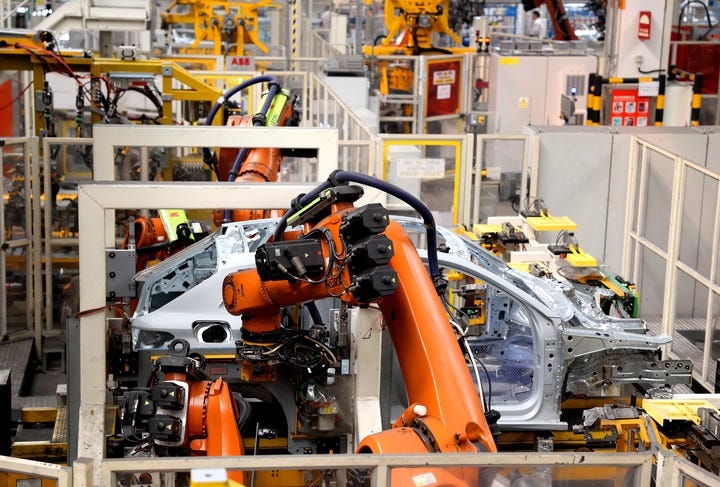Must-Read China Economic News (April 11-17)
China's GDP expands 5.4% in first quarter; greater efforts urged to boost nation's consumption; and China's response to U.S. unilateral tariff measures...
Greetings and welcome to the latest edition of Peking Ensight! We're thrilled to have you join us once again as we navigate the ever-evolving landscape of the Chinese economy.
⭐Under the Spotlight
China's GDP expands 5.4 pct year on year in Q1
China's gross domestic product (GDP) grew 5.4 percent year on year to 31.8758 trillion yuan (about 4.42 trillion U.S. dollars) in the first quarter of 2025, latest data from the National Bureau of Statistics (NBS) showed.
On a quarterly basis, the economy increased 1.2 percent in the first three months.
Highlighting remarkable gains across major indicators, NBS deputy head Sheng Laiyun pointed out that value-added industrial output expanded 6.5 percent year on year. Retail sales of consumer goods, a major indicator of the country's consumption strength, gained 4.6 percent, while fixed-asset investment went up 4.2 percent.
The data also showed that the country's per capita disposable income increased by 5.5 percent in nominal terms to 12,179 yuan in the first quarter, with the employment situation remaining stable.
China's GDP grew 5 percent year on year last year and the country has targeted its full-year economic growth at around 5 percent for 2025.
Chinese premier stresses greater efforts to boost consumption
Chinese Premier Li Qiang has called for greater efforts to boost consumption, expand domestic demand, strengthen domestic circulation, and further unleash the vitality and potential of China's ultra-large market to address challenges posed by external shocks.
Li, also a member of the Standing Committee of the Political Bureau of the Communist Party of China Central Committee, made the remarks during an investigation and research tour in Beijing.
When inspecting a local exhibition promoting domestic sales of foreign trade firms, Li noted that while profound changes in the external environment have caused adverse effects on China's exports, foreign trade companies should actively explore diversified markets and innovate sales channels to keep foreign trade stable.
Li stressed efforts to make good use of existing policies to promote domestic sales of foreign trade goods, further carry out actions to boost consumption, and encourage healthy competition among firms to create new demand with high-quality supply.
China to reinforce financial support for sports industry
China will continue to beef up financial support for the sports industry in a bid to promote high-quality development of the sector, according to a government guideline.
The guideline has proposed 16 specific supportive measures, including increasing financial support for the construction of sports infrastructure and the development of sports venues, ice and snow sports facilities, and outdoor sports destinations.
China will reinforce financial supply for the manufacturing of sports goods, leverage the financial sector's role in promoting sports consumption and improve financial services to empower the ice and snow economy, according to the guideline.
Efforts will also be made to forge diversified financial services for the sports industry, including leveraging the financing role of the bonds market and enhancing the insurance sector's coverage for the sports industry.
China's trade-in program boosts home appliance sales
China has seen more than 100 million new home appliances sold as of April 10, 2025 since the country intensified efforts to implement the consumer goods trade-in program in August 2024, according to the Ministry of Commerce.
Starting this year, China also expanded the range of subsidized appliances from eight categories to 12, and increased the number of air conditioners that can be subsidized to three per person, the ministry said.
Local governments have also beefed up efforts to streamline the program. More than 7,000 consumption-boosting activities for home appliances have already been organized, with nearly 30,000 more planned for the year.
The ministry said it will guide local departments to further strengthen their work, optimize the operation process, and achieve better results through the program.
⭐China's response to U.S. trade bullying
China raises additional tariffs to 125 pct on U.S. imports
China has raised the additional tariffs on products imported from the United States to 125 percent, effective from April 12, the Customs Tariff Commission of the State Council announced.
This followed the U.S. move to raise the "reciprocal tariffs" on Chinese imports to 125 percent. The commission said the U.S. imposition of excessively high tariffs on China seriously violates international economic and trade rules, goes against basic economic laws and common sense, and is nothing but unilateral bullying and coercion.
A Chinese commerce ministry spokesperson said that the United States should take full responsibility for its unilateral tariff measures, which have caused significant disruptions and severe turbulence in the world economy, global markets and the multilateral trading system.
The spokesperson said that the U.S. move to postpone imposing high tariffs on certain trading partners under pressure from China and other parties represents only a symbolic and minimal step, and the nature of using trade coercion by the United States for its own gains has not changed.
China urges the U.S. side to immediately correct its wrong practices and cancel all unilateral tariff measures imposed on the country, the spokesperson said.
The Customs Tariff Commission of the State Council said that even if the United States imposes even higher tariffs, it would no longer make economic sense and ultimately go down as a joke in world economic history.
"Given that it's already impossible for the Chinese market to accept U.S. imports at the current tariff level, if the United States imposes further tariffs on Chinese products, China will ignore it," the commission said.
However, should the United States persist in substantially undermining China's interests, China will take firm countermeasures and fight to the end, the commission added.
"China remains open to consultations with the United States, but believes that threats and pressure are not the correct approaches to engage with China," the commerce ministry spokesperson said, urging the United States to resolve differences with China through dialogue based on mutual respect.
Chinese official says U.S. tariff hikes won't change China's long-term positive growth prospects
U.S. tariff increases on Chinese products will exert some pressure on China's trade and economy in the short term, but won't alter the Chinese economy's long-term positive trajectory, according to a senior official with the National Bureau of Statistics (NBS).
"We strongly oppose the United States imposing tariff barriers and engaging in trade bullying, as such actions are detrimental to all parties," NBS Deputy Director Sheng Laiyun told a press conference on April 16.
Citing the Chinese economy's solid fundamentals and strong resilience, Sheng said the country has the confidence and capability to tackle external challenges and achieve its economic development goals.
China aims to grow its GDP by around 5 percent year on year in 2025. NBS data showed that the Chinese economy expanded 5.4 percent year on year in the first quarter of this year, up 1.2 percent compared with the previous quarter.
Since reform and opening up, China's economy has weathered significant challenges and gained extensive experience in terms of macroeconomic management, Sheng noted, while adding that China will implement incremental policies in response to changes in the external environment.
"A robust toolbox of policy measures ensures our capacity to address external shocks and challenges," Sheng explained.
⭐Key Macroeconomic Indicators
China's foreign trade grew 1.3 pct in Q1
China's total goods imports and exports in yuan-denominated terms expanded 1.3 percent year on year in the first quarter of this year, demonstrating stable growth and strong resilience despite external headwinds.
According to the General Administration of Customs (GAC), China's exports during the period rose 6.9 percent to 6.13 trillion yuan (about 850.1 billion U.S. dollars) while imports fell 6 percent to 4.17 trillion yuan.
Despite the weak momentum of global economic growth, intensified trade protectionism and geopolitical tensions, China's foreign trade has maintained stable growth with progress in high-quality development this year, Wang Lingjun, deputy head of the GAC, told a press conference.
The country's foreign trade continued to see structural improvement. The imports and exports of the equipment manufacturing sector expanded 7.6 percent year on year in January-March, accounting for about half of the country's total foreign trade, according to the GAC.
GAC spokesperson Lyu Daliang said China's exports to more than 170 countries and regions expanded in the first three months, with strong growth seen in the high-end, smart and green manufacturing sectors.
Looking ahead, Lyu said China has huge potential for import growth, and the country's vast market always presents a great opportunity for the world.
China reports robust growth in NEV production, sales in Q1
China's new energy vehicles (NEVs) saw robust production and sales in the first quarter of 2025, with production surging 50.4 percent year on year to 3.18 million units and sales soaring 47.1 percent year on year to 3.08 million units, according to the China Association of Automobile Manufacturers (CAAM).
NEV sales accounted for 41.2 percent of total vehicle sales in the period, according to CAAM data.
According to the association, China's auto industry got off to a steady start as both production and sales achieved double-digit growth in the period, driven by the implementation of measures aimed at spurring auto consumption.
The data also showed that China's auto exports maintained a steady growth momentum, with a year-on-year increase of 7.3 percent in the first quarter. Notably, NEV exports soared 43.9 percent year on year to 441,000 units.
Compiled by Allen Zhu











